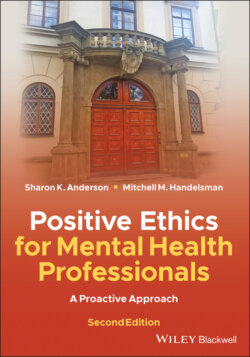Читать книгу Positive Ethics for Mental Health Professionals - Sharon K. Anderson - Страница 43
Discrimination and Oppression
ОглавлениеDiscrimination refers to behaviors that usually stem from prejudiced feelings or thoughts and “which denies individuals or groups of people equality of treatment” (Blumenfeld & Raymond, 2000, p. 22). In our opening story, two women of color were both targets of discrimination (not being acknowledged or seen—treated as if they were invisible and denied service) while the White person just behind them was acknowledged and treated respectfully.
The following example is something that happened in Sharon’s family some years ago when her children were young and interacted with neighborhood families. The experience addresses another type of privilege and discrimination:
Bobby (9 years old at the time) said to me (Sharon), “Mom, when we (he and his sister Taya, 8 years old at the time) go over to the neighbor’s house to see if Kenny can play, Gene always says, ‘Bobby’s at the door.’ He doesn’t say anything about Taya.” I asked Bobby why he thought Gene didn’t mention Taya when he announced who was at the door. He said he thought it was that Gene didn’t like Taya. I responded, “That might be true. It might also be that he doesn’t see Taya as ‘counting’ or deserving notice.” The assumption might be that Taya is “invisible” to Gene because of her gender. Whether or not that is Gene’s intent, the covert message to Taya may be, “Bobby, you’re visible and important to recognize (male privilege) and Taya, you’re female; therefore, invisible and don’t count.”
In all three experiences, the harm was overt and personal. All three individuals were made aware of their “invisibility” by another individual. If we’re honest here, there was also some indirect or covert harm that Sharon participated in as she listened to her friend talk about the experience of being invisible at the fast-food restaurant. Sharon initially didn’t believe that such a thing could happen—internally discounting her friend’s experience of discrimination. Sharon couldn’t see her friend’s experience of invisibility because of her own unexamined White privilege and resulting participation in systems of oppression. When discrimination takes place on a larger scale, we talk about oppression, which refers to “the systematic, institutionalized mistreatment of one group of people by another” (Lustig & Koester, 1999, p. 159). There is a relationship among discrimination, oppression, and privilege. The equation might look like this: discrimination + privilege (social power) = oppression.
When we become aware of our own points of privilege, we may be able more fully to really hear, empathize with, and respect some of our clients’ experiences of discrimination and oppression and thereby acknowledge, rather than discount, their experience (Furman, 2005; Sue et al., 2019; Tuason, 2005).
